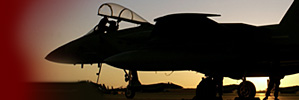|
Feature: Boneyard
Back To Page 1

The bus passes a lone B-52 G. Beginning
their operational service in 1954, Boeing now estimates that
the airframes of these aircraft will last past the year 2040,
and it is very possible they will remain in service nearly
100 years. Already the sons of B-52 pilots have the flown
the same aircraft as their fathers. It is conceivable that
their sons will be Buff pilots as well.
I heard a story about a B1-B Lancer
bomber crew who had flown their aircraft to Davis Monthan
Air Force base for the last time, because it was being retired.
A reserved spot in the Boneyard. As they turned to walk away
from the aircraft for the last time, emotion got the better
of them and there were no dry eyes. "That's a beautiful
aircraft." they were heard to say.


I know I am not alone in this passion.
I recently spent some time talking with men who flew B-24
Liberator bombers, B-17 Flying Fortress bombers, and B-29
Super Fortress bombers, and it was clear how they felt personally
about the aircraft they flew into combat as young men. One
lamented the fact that there was currently only one operational
B-24 in the entire world. Witness the extraordinary attempts
at recovery of WW II era fighters and bombers. Thousands were
mass produced for the war effort, but now only a handful remain.
I have seen documentaries on some
of the efforts. People have invested their time, their fortunes,
and their lives, in order to recover machines made of aluminum,
rubber, steel, and glass. In 1992, a recovery team went to
Greenland and was able to extract an aircraft from the "Lost
Squadron", a P-38 Lightning, named "Glacier Gal"
from beneath a covering of almost 300 feet of ice. In 1993,
another team attempted the recovery of a B-29 bomber, the
"Kee Bird" from a frozen lake in the northwest portion
of Greenland, actually above the artic circle. Unfortunately,
one man died during the recovery effort, and as they were
attempting to fly the aircraft out, an auxiliary power generator
in the rear of the aircraft broke loose and created a fire
which destroyed the great bomber just moments away from what
could have been her final flight home. A neighbor of mine
was a member of that team.
Still, I am not sure why I feel as
I do. Perhaps it's because I have "flown" some of
these aircraft on a personal computer with flight simulators.
Today's computer flight simulations are of a very high fidelity
and with amazing graphics. Some have been compared favorably
with military simulators. I have performed the engine startup
sequence in an F-16, and flown carrier landings, or "traps",
in an F/A-18 Hornet and hit the "three wire". I
instantly recognize the cockpits of F-15 Eagles, A-10 Thunderbolt
II's, F-4 Phantoms, A-6 Intruders, F-14 Tomcats and more.
I have spent hours going through complicated radar, defensive,
and weapons systems routines. The missions can be quite complicated
and demanding, but once completed, you definitely feel a sense
of accomplishment. And maybe a sense of attachment to the
simulated aircraft that got you there and back.
"Boneyard. That's what this place
used to be called." The voice of Larry, our tour guide
for the one hour and ten minute bus ride through AMARC. "But
the Air Force prefers the acronym AMARC, for Aerospace Maintenance
And Regeneration Center. This is not just a place where aircraft
go to be chopped up into pieces. Virtually all the aircraft
here flew in on their power and over twenty percent will be
refitted and will fly again. Some will be sold to other countries,
some will go the Mojave range and be used as drones."
I know he's right and yet…
Although I have lived in Tucson much
of my life, I hadn't learned much about the Boneyard. As a
boy I spent many a morning on a dirt road with a barbed wire
fence alongside it, searching for aircraft parts and hoping
to find something interesting to take home. My intentions,
if I recall, were to build my own jet aircraft cockpit at
home. Gauges and switches were especially prized. I dreamed
of finding a joystick by the side of that road, but never
did. When I was ten I bought an old military surplus helmet
and oxygen mask and swaggered around the house pretending
to be a fighter ace returning from a harrowing combat mission.
Education is a wonderful thing, even
for someone of my advanced age, and taking the AMARC tour
was worthwhile. Actually seeing what is happening, the process
and procedures, and having it explained opened my eyes considerably.
Plus, I did some research on my own. What I found was that
far from being a "Boneyard", AMARC is a joint-use
refitting and reclamation facility with all types of aircraft
from all branches of the military. Heavy bombers, tactical
bombers, fighters, fighter/bombers, refueling tankers, transports,
search and rescue, electronic surveillance/command and control,
electronic warfare, anti-submarine, helicopters, they're all
here.

Touring the base and seeing aircraft
in various stages of dismantling does lends credence to the
"Boneyard" description at first glance. There are
portions that look like an aircraft junkyard with parts littered
around, airframes sitting in wooden cradles with the tail
assemblies and wings removed. But it actually is a very effective
and efficient process, with the goal in mind of maximizing
the value of every single component part on each aircraft.
While it may look haphazard to the untrained eye, everything
here is done in a very deliberate and controlled manner. Parts
are removed as needed while protecting the rest of the aircraft
for future use until literally there is nothing left but scrap.
Go
To Page 3
Click
here to go to top of this page.
Copyright 2008, SimHQ.com. All Rights Reserved. Contact the webmaster.
|

